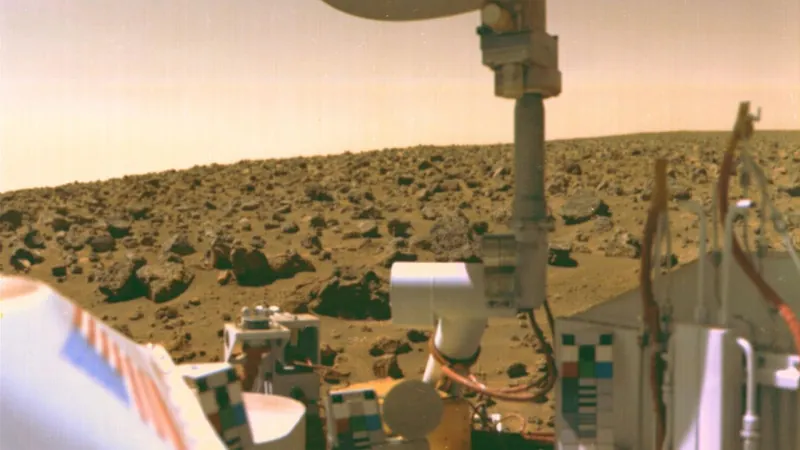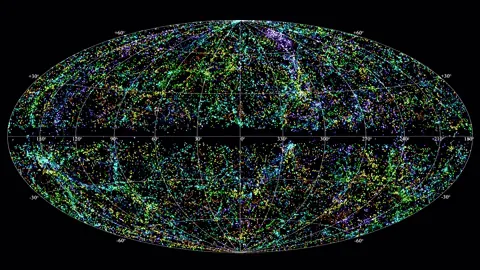
Did NASA's Viking Landers Unknowingly Annihilate Martian Life? A Scientist's Bold Theory Unveiled
2024-11-15
Author: Mei
Introduction
For nearly half a century, NASA's Viking landers have been at the forefront of discussions concerning extraterrestrial life, particularly on Mars. One scientist is now urging a fresh examination of these historic experiments and proposes that they may have inadvertently extinguished potential Martian life.
Background on Viking Missions
The Viking missions, launched in the 1970s, were vital as they marked the first direct life detection experiments on another planet. While the results baffled researchers at the time, years of additional knowledge about Mars' environment and extremophiles — organisms thriving in Earth's harshest conditions — offer a different lens through which to view these findings.
Insights from Desert Research
Drawing parallels from extensive work in the Atacama Desert, a Martian analog, the scientist discovered critical insights into how organisms can survive in arid environments with minimal water. Interestingly, during a recent gathering on life beyond Earth, held by the King of the Netherlands, European Space Agency scientists reacted positively to this provocative hypothesis.
Theory Explanation
At the heart of the theory lies the unique interaction between salts and atmospheric moisture. Certain salts, with their capacity to draw water from the environment, could provide a lifeline for surviving organisms on a desiccated Mars. Remarkably, water can remain in the form of a subsaturated brine in these salts due to a phenomenon known as hysteresis, preserving it for microbial use longer than one might expect.
Analogies with Microbial Responses
Imagine if, instead of being put in a desert, a human was thrown into the ocean. It would be ultimately harmful. This is analogous to what might have happened during the Viking experiments — too much water could have deleteriously affected Martian microbes. The comparison extends to the way certain bacteria on Earth respond to sudden floods, with studies showing that up to 80% of indigenous microbes perished after heavy rains in the Atacama Desert.
Future Detection Methods
Importantly, discussing life detection methods, the researcher emphasizes the need for multiple independent approaches. Current advancements, including using artificial intelligence to discern the movements of potential Martian microbes from sediment particles, offer promising avenues for future exploration.
Technological Enhancements
Moreover, the idea of employing sophisticated techniques like gas chromatography and mass spectrometry can deepen our understanding of organic materials sampled from Mars. Such technologies could identify specific proteins or even organic molecules produced through non-biological processes — enhancing our ability to differentiate between life and non-life indicators.
Exciting Frontiers in Search for Life
Notably, the focus on hygroscopic salts, particularly sodium chloride, as potential microbial habitats presents an exciting frontier in the quest for extraterrestrial life. The possible existence of chlorates and perchlorates, which remain liquid at lower temperatures, could also be investigated as favorable environments for life.
Conclusion
While challenging existing paradigms can be contentious within the scientific community, the scientist remains optimistic. Science thrives on debate and testing hypotheses. Just because some may disagree doesn’t mean we shouldn't continue exploring the possibilities. Future missions should meticulously investigate the idea that Viking's presence may have inadvertently altered Mars’ potential for life.
As we look ahead, the key takeaway resonates: we must apply diverse and innovative methods in the search for Martian life. Whether the Viking landers did indeed snuff out a form of existence is still a matter of speculation, but within the exploration of the Red Planet's mysteries, one truth remains undeniable — discovery awaits those who dare to explore beyond our terrestrial boundaries.




 Brasil (PT)
Brasil (PT)
 Canada (EN)
Canada (EN)
 Chile (ES)
Chile (ES)
 España (ES)
España (ES)
 France (FR)
France (FR)
 Hong Kong (EN)
Hong Kong (EN)
 Italia (IT)
Italia (IT)
 日本 (JA)
日本 (JA)
 Magyarország (HU)
Magyarország (HU)
 Norge (NO)
Norge (NO)
 Polska (PL)
Polska (PL)
 Schweiz (DE)
Schweiz (DE)
 Singapore (EN)
Singapore (EN)
 Sverige (SV)
Sverige (SV)
 Suomi (FI)
Suomi (FI)
 Türkiye (TR)
Türkiye (TR)